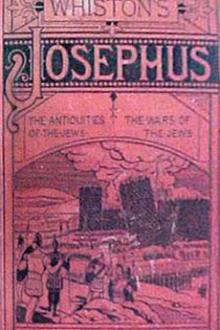The Wars of The Jews by Flavius Josephus (easy readers .TXT) 📖

- Author: Flavius Josephus
- Performer: -
Book online «The Wars of The Jews by Flavius Josephus (easy readers .TXT) 📖». Author Flavius Josephus
were of three stories high; there were also entrances on each side into them from the gate of the temple. But the superior part of the temple had no such little houses any further, because the temple was there narrower, and forty cubits higher, and of a smaller body than the lower parts of it. Thus we collect that the whole height, including the sixty cubits from the floor, amounted to a hundred cubits.
6. Now the outward face of the temple in its front wanted nothing that was likely to surprise either men’s minds or their eyes; for it was covered all over with plates of gold of great weight, and, at the first rising of the sun, reflected back a very fiery splendor, and made those who forced themselves to look upon it to turn their eyes away, just as they would have done at the sun’s own rays. But this temple appeared to strangers, when they were coming to it at a distance, like a mountain covered with snow; for as to those parts of it that were not gilt, they were exceeding white. On its top it had spikes with sharp points, to prevent any pollution of it by birds sitting upon it. Of its stones, some of them were forty-five cubits in length, five in height, and six in breadth.
Before this temple stood the altar, fifteen cubits high, and equal both in length and breadth; each of which dimensions was fifty cubits. The figure it was built in was a square, and it had corners like horns; and the
passage up to it was by an insensible acclivity. It was formed without any iron tool, nor did any such iron tool so much as touch it at any time. There was also a wall of partition, about a cubit in height, made of fine stones, and so as to be grateful to the sight; this encompassed the holy house and the altar, and kept the people that were on the outside off from the priests. Moreover, those that had the gonorrhea and the leprosy were excluded out of the city entirely; women also, when their courses were upon them, were shut out of the temple; nor when they were free from that impurity, were they allowed to go beyond the limit before-mentioned; men also, that were not thoroughly pure, were prohibited to come into the inner [court of the] temple; nay, the priests themselves that were not pure were prohibited to come into it also.
7. Now all those of the stock of the priests that could not minister by reason of some defect in their bodies, came within the partition, together with those that had no such imperfection, and had their share with them by reason of their stock, but still made use of none except their own private garments; for nobody but he that officiated had on his sacred garments; but then those priests that were without any blemish upon them went up to the altar clothed in fine linen. They abstained chiefly from wine, out of this fear, lest otherwise they should transgress some rules of their ministration. The high priest did also go up with them; not always indeed, but on the seventh days and new moons, and if any festivals belonging to our nation, which we celebrate every year, happened. When he officiated, he had on a pair of breeches that reached beneath his privy parts to his thighs, and had on an inner garment of linen, together with a blue garment, round, without seam, with fringe work, and reaching to the feet. There were also golden bells that hung upon the fringes, and pomegranates intermixed among them. The bells signified thunder, and the pomegranates lightning. But that girdle that tied the garment to the breast was embroidered with five rows of various colors, of gold, and purple, and scarlet, as also of fine linen and blue, with which colors we told you before the veils of the temple were embroidered also. The like embroidery was upon the ephod; but the quantity of gold therein was greater. Its figure was that of a stomacher for the breast. There were upon it two golden buttons like small shields, which buttoned the ephod to the garment; in these buttons were enclosed two very large and very excellent sardonyxes, having the names of the tribes of that nation engraved upon them: on the other part there hung twelve stones, three in a row one way, and four in the other; a sardius, a topaz, and an emerald; a carbuncle, a jasper, and a sapphire; an agate, an amethyst, and a ligure; an onyx, a beryl, and a chrysolite; upon every one of which was again engraved one of the forementioned names of the tribes. A mitre also of fine linen encompassed his head, which was tied by a blue ribbon, about which there was another golden crown, in which was engraven the sacred name [of God]: it consists of four vowels. However, the high priest did not wear these garments at other times, but a more plain habit; he only did it when he went into the most sacred part of the temple, which he did but once in a year, on that day when our custom is for all of us to keep a fast to God. And thus much concerning the city and the temple; but for the customs and laws hereto relating, we shall
speak more accurately another time; for there remain a great many things thereto relating which have not been here touched upon.
8. Now as to the tower of Antonia, it was situated at the corner of two cloisters of the court of the temple; of that on the west, and that on the north; it was erected upon a rock of fifty cubits in height, and was on a great precipice; it was the work of king Herod, wherein he demonstrated his natural magnanimity. In the first place, the rock itself was covered over with smooth pieces of stone, from its foundation, both for ornament, and that any one who would either try to get up or to go down it might not be able to hold his feet upon it. Next to this, and before you come to the edifice of the tower itself, there was a wall three cubits high; but within that wall all the space of the tower of Antonia itself was built upon, to the height of forty cubits. The inward parts had the largeness and form of a palace, it being parted into all kinds of rooms and other
conveniences, such as courts, and places for bathing, and broad spaces for camps; insomuch that, by having all conveniences that cities wanted, it might seem to be composed of several cities, but by its magnificence it seemed a palace. And as the entire structure resembled that of a tower, it contained also four other distinct towers at its four corners; whereof the others were but fifty cubits high; whereas that which lay upon the southeast corner was seventy cubits high, that from thence the whole temple might be viewed; but on the corner where it joined to the two cloisters of the temple, it had passages down to them both, through which the guard (for there always lay in this tower a Roman legion) went several ways among the cloisters, with their arms, on the Jewish festivals, in order to watch the people, that they might not there attempt to make any innovations; for the temple was a fortress that guarded the city, as was the tower of Antonia a guard to the temple; and in that tower were the guards of those three (14).
There was also a peculiar fortress belonging to the upper city, which was Herod’s palace; but for the hill Bezetha, it was divided from the tower Antonia, as we have already told you; and as that hill on which the tower of Antonia stood was the highest of these three, so did it adjoin to the new city, and was the only place that hindered the sight of the temple on the north. And this shall suffice at present to have spoken about the city and the walls about it, because I have proposed to myself to make a more accurate
description of it elsewhere.
CHAPTER 6.
Concerning The Tyrants Simon And John. How Also As Titus Was Going Round The Wall Of This City Nicanor Was Wounded By A Dart; Which Accident Provoked Titus To Press On The Siege.
1. Now the warlike men that were in the city, and the multitude of the seditious that were with Simon, were ten thousand, besides the Idumeans. Those ten thousand had fifty commanders, over whom this Simon was supreme. The Idumeans that paid him homage were five thousand, and had eight commanders, among whom those of greatest fame were Jacob the son of Sosas, and Simon the son of Cathlas. Jotre, who had seized upon the temple, had six thousand armed men under twenty commanders; the zealots also that had come over to him, and left off their opposition, were two thousand four hundred, and had the same commander that they had formerly, Eleazar, together with Simon the son of Arinus. Now, while these factions fought one against another, the people were their prey on both sides, as we have said already; and that part of the people who would not join with them in their wicked practices were plundered by both factions. Simon held the upper city, and the great wall as far as Cedron, and as much of the old wall as bent from Siloam to the east, and which went down to the palace of Monobazus, who was king of the Adiabeni, beyond Euphrates; he also held that fountain, and the Acra, which was no other than the lower city; he also held all that reached to the palace of queen Helena, the mother of Monobazus. But John held the temple, and the parts thereto adjoining, for a great way, as also Ophla, and the valley called “the Valley of Cedron;” and when the parts that were interposed between their possessions were burnt by them, they left a space wherein they might fight with each other; for this internal sedition did not cease even when the Romans were encamped near their very wall. But although they had grown wiser at the first onset the Romans made upon them, this lasted but a while; for they returned to their former madness, and separated one from another, and fought it out, and did everything that the besiegers could desire them to do; for they never suffered any thing that was worse from the Romans than they made each other suffer; nor was there any misery endured by the city after these men’s actions that could be esteemed new. But it was most of all unhappy before it was overthrown, while those that took it did it a greater kindness for I venture to affirm that the sedition destroyed the city, and the Romans destroyed the sedition, which it was a much harder thing to do than to destroy the walls; so that we may justly ascribe our misfortunes to our own people, and the just vengeance taken on them to the
Romans; as to which matter let every one determine by the actions on both sides.
2. Now when affairs within the city were in this posture, Titus went round the city on the outside with some chosen horsemen, and looked about for a proper place where he





Comments (0)